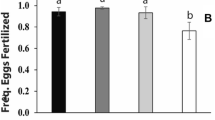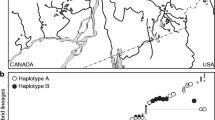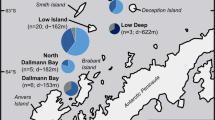Abstract
Biological invasions involving hybridization proceed according to prezygotic and postzygotic reproductive isolating mechanisms. Yet few comparisons of reproductive isolation have been carried out to understand how different mechanisms prevent or promote invasions involving hybridization. Here we present a study of prezygotic and postzygotic isolation between non-native red shiner (Cyprinella lutrensis) and native blacktail shiner (C. venusta stigmatura) from the Coosa River basin (USA) to better understand the formation and expansion of invasive hybrid swarms. We conducted spawning trials to measure mating preferences and raised broods from crosses to assay hybrid viability through early juvenile development. Females of both species were more responsive to conspecific mates, although blacktail shiner females responded more often to heterospecific mates than did red shiner females. Fecundity of red shiner females was also higher than blacktail shiner females. Heterospecific crosses resulted in lower fertilization and egg hatching rates, but we found no other evidence of inviability. Rather, we found comparatively low larval mortality of F1 hybrids, which is suggestive of heterosis. These findings support prior inferences of assortative mating from genetic descriptions of hybridization, and that the invasion in the Coosa River is likely proceeding due to interspecific competition and intrinsic hybrid viability.




Similar content being viewed by others
References
Agresti A (1996) An introduction to categorical data analysis. Wiley, New York
Alexander HJ, Breden F (2004) Sexual isolation and extreme morphological divergence in the Cumana guppy: a possible case of incipient speciation. J Evol Biol 17:1238–1254
Ayres DR, Zaremba K, Sloop CM, Strong DR (2008) Sexual reproduction of cordgrass hybrids (Spartina foliosa x alterniflora) invading tidal marshes in San Francisco Bay. Divers Distrib 14:187–195
Bolnick DI, Near TJ (2005) Tempo of hybrid inviability in Centrarchid fishes (Teleostei: Centrarchidae). Evolution 59:1754–1767
Boughman JW (2001) Divergent sexual selection enhances reproductive isolation in sticklebacks. Nature 411:944–948
Broughton RE, Gold JR (2000) Phylogenetic relationships in the North American cyprinid genus Cyprinella (Actinopterygii: Cyprinidae) based on sequences of the mitochondrial ND2 and ND4L genes. Copeia 2000:1–10
Burkhead NM, Blum MJ, Walters DM, Porter BA, Freeman BJ, Fontaine JA (2006) Hybrid swarms, aggressive hybridization, and the red shiner: Miscues or mystery? Proceedings of the American Fisheries Society Annual Conference, American Fisheries Society
Candolin U, Salesto T, Evers M (2007) Changed environmental conditions weaken sexual selection in sticklebacks. J Evol Biol 20:233–239
Childs MR, Echelle AA, Dowling TE (1996) Development of the hybrid swarm between Pecos pupfish (Cyprinodontidae: Cyprinodon pecosensis) and sheepshead minnow (Cyprinodon variegatus): a perspective from allozymes and mtDNA. Evolution 50:2014–2022
Couch CA, DeVivo JC, Freeman BJ (1995) What fish live in the streams of metropolitan Atlanta? U.S. Geological Survey, National Water Quality Assessment Program, Fact sheet FS-091-95, Georgia
Coyne JA (1993) The genetics of an isolating mechanism between two sibling species of Drosophila. Evolution 47:778–788
Coyne JA, Orr HA (2004) Speciation. Sinauer, Massachusetts
DeGroot MH (1986) Probability and statistics, 2nd edn. Wesley, Massachusetts
Delco EA (1960) Sound discrimination by males of two cyprinid fishes. Tex J Sci 12:48–54
DeVivo JC (1996) Fish assemblages as indicators of water quality within the Apalachiacola-Chattahoochee-Flint (ACF) River basin. M.S. thesis. Institute of Ecology, The University of Georgia, Athens, Georgia
Echelle AA, Connor PJ (1989) Rapid geographically extensive genetic introgression after secondary contact between two pupfish species (Cyprinodon, Cyprinodontidae). Evolution 43:717–727
Echelle AA, Echelle AF (1997) Genetic introgression of endemic taxa by non-natives: a case study with Leon Springs pupfish and sheepshead minnow. Conserv Biol 11:153–161
Ellstrand NC, Schierenbeck KA (2000) Hybridization as a stimulus for the evolution of invasiveness in plants? Proc Natl Acad Sci USA 97:7043–7050
Endler JA, Houde AE (1995) Geographic-variation in female preferences for male traits in Poecilia reticulata. Evolution 49:456–468
Engström-Öst J, Candolin U (2007) Human-induced water turbidity alters selection on sexual displays in sticklebacks. Behav Ecol 18:393–398
Epifanio J, Philipp D (2001) Simulating the extinction of parental lineages from introgressive hybridization: the effects of fitness, initial proportions of parental taxa, and mate choice. Rev Fish Biol Fish 10:339–354
Ferdy JB, Austerlitz F (2002) Extinction and introgression in a community of partially cross-fertile plant species. Am Nat 160:74–86
Field DL, Ayre DJ, Whelan RJ, Young AG (2008) Relative frequency of sympatric species influences rates of interspecific hybridization, seed production, and seedling performance in the uncommon Eucalyptus aggregata. J Ecol 96:1198–1210
Fuller PL, Nico LG, Wiliams JD (1999) Nonindigenous fishes introduced into inland waters of the United States. American Fisheries Society, Special Publication 27, Bethesda
Fuller RC, McGhee KE, Schrader M (2007) Speciation in killifish and the role of salt tolerance. J Evol Biol 20:1962–1975
Garraway CJ, Bowman J, Cascaden TJ, Holloway GL, Mahan CG, Malcolm JR, Steele MA, Turner G, Wilson PJ (2010) Climate change induced hybridization in flying squirrels. Glob Chang Biol 16:113–121
Gilbert CR (1961) Hybridization versus intergradation: an inquiry into the relationship of two cyprinid fishes. Copeia 1961:181–192
Hall RJ, Hastings A, Ayres DR (2006) Explaining the explosion: modeling a hybrid invasion. Proc R Soc Lond B Biol Sci 273:1385–1389
Hankison SJ, Morris MR (2002) Sexual isolation and species recognition in the pygmy swordtail, Xiphophorus pygmaeus: conflicting preferences. Behav Ecol Sociobiol 51:140–145
Hatfield T, Schluter D (1996) A test for sexual selection on hybrids of two sympatric sticklebacks. Evolution 50:2429–2434
Herrington SJ (2004) Ecology and impacts of nonindigenous red shiner in the Chattahoochee River drainage, Georgia. Ph.D. thesis, Department of Fisheries and Allied Aquacultures, Auburn University, Auburn, Alabama
Hubbs C, Strawn K (1956) Interfertility between two sympatric fishes, Notropis lutrensis and Notropis venustus. Evolution 10:341–344
Hubbs C, Kuehne RA, Ball JC (1953) The fishes of the upper Guadalupe River, Texas. Tex J Sci 5:216–244
Huxel GR (1999) Rapid displacement of native species by invasive species: effects of hybridization. Biol Conserv 89:143–152
Järvenpää M, Lindström K (2004) Water turbidity by algal blooms causes mating system breakdown in a shallow-water fish, the sand goby Pomatoschistus minutus. Proc R Soc Lond B Biol Sci 271:2361–2365
Jiggins CD, Mallet J (2000) Bimodal hybrid zones and speciation. TREE 15:250–255
Johnston CE (1999) The relationship of spawning mode to conservation of North American minnows (Cyprinidae). Environ Biol Fishes 55:21–30
Jurgens KC (1951) The distribution and ecology of the fishes of the San Marcos River. M.S. thesis, Department of Zoology, The University of Texas, Austin, Texas
Kodric-Brown A, Rosenfield JA (2004) Populations of Pecos pupfish (Cyprinidon pecosensis) differ in their susceptibility to hybridization with sheepshead minnow (C. variegatus). Behav Ecol Sociobiol 56:116–123
Larimore RW, Bayley PB (1996) The fishes of Champaign County, Illinois, during a century of alterations of a prairie ecosystem. Ill Nat Hist Survey Bull 35:53–183
Lee CE (2002) Evolutionary genetics of invasive species. TREE 17:386–391
Luyten PH, Liley NR (1991) Sexual selection and competitive mating success of male guppies (Poecilia reticulata) from four Trinidad populations. Behav Ecol Sociobiol 28:329–336
Matthews WJ (1985) Distribution of midwestern fishes on multivariate environmental gradients with emphasis on Notropis lutrensis. Am Midl Nat 113:225–237
Matthews WJ, Hill LG (1979) Influence of physico-chemical factors on habitat selection by red shiners, Notropis lutrensis (Pisces: Cyprinidae). Copeia 1979:70–81
Mendelson TC (2003) Sexual isolation evolves faster than hybrid inviability in a diverse and sexually dimorphic genus of fish (Percidae: Etheostoma). Evolution 57:317–327
Mendelson TC, Imhoff VE, Kathryn Iovine M (2006) Analysis of early embryogenesis in Rainbow and Banded Darters (Percidae: Etheostoma) reveals asymmetric postmating barrier. Environ Biol Fishes 76:351–360
Mousseau TA, Fox CW (1998) The adaptive significance of maternal effects. TREE 13:403–407
Near TJ, Keck BP (2005) Dispersal, vicariance, and timing of diversification in Nothonutus darters. Mol Ecol 14:3485–3496
Page LM, Smith RL (1970) Recent range adjustments and hybridization of Notropis lutrensis and Notropis spilopterus in Illinois. Trans Ill State Acad Sci 63:264–272
Pfennig K (2007) Facultative mate choice drives adaptive hybridization. Science 318:965–967
Phillips CT, Johnston CE (2008a) Geographic divergence of acoustic signals in Cyprinella galactura, the whitetail shiner (Cyprinidae). Anim Behav 75:617–626
Phillips CT, Johnston CE (2008b) Sound production and associated behaviors in Cyprinella galactura. Environ Biol Fishes 82:265–275
Rhymer JM, Simberloff D (1996) Extinction by hybridization and introgression. Annu Rev Ecol Syst 27:83–109
Rosenfield JA, Kodric-Brown A (2003) Sexual selection promotes hybridization between Pecos pupfish, Cyprinodon pecosensis and sheepshead minnow, C. variegatus. J Evol Biol 16:595–606
Rosenfield JA, Nolasco S, Lindauer S, Sandoval C, Kodric-Brown A (2004) The role of hybrid vigor in the replacement of Pecos pupfish by its hybrids with sheepshead minnow. Conserv Biol 18:1589–1598
Rundle HD, Nagel L, Boughman JW, Schluter D (2000) Natural selection and parallel speciation in sympatric sticklebacks. Science 287:306–308
Russell ST (2003) Evolution of intrinsic post-zygotic reproductive isolation in fish. Ann Zool Fenn 40:321–329
Sakai AK, Allendorf FW, Holt JS, Lodge DM, Molofsky J, With KA et al (2001) The population biology of invasive species. Annu Rev Ecol Syst 32:305–332
Seehausen O, van Alphen JM (1998) The effect of male coloration on female mate choice in closely related Lake Victoria cichlids (Haplochromis nyererei complex). Behav Ecol Sociobiol 42:1–8
Seehausen O, van Alphen JM, Witte F (1997) Cichlid fish diversity threatened by eutrophication that curbs sexual selection. Science 277:1808–1811
Seehausen O, Takimoto G, Roy D, Jokela J (2008) Speciation reversal and biodiversity dynamics with hybridization in changing environments. Mol Ecol 17:30–44
Sloop CM, Ayres DR, Strong DR (2009) The rapid evolution of self-fertility in Spartina hybrids (Spartina alterniflora x foliosa) invading San Francisco Bay, CA. Biol Invasions 11:1131–1144
Stout JF (1975) Sound communication during the reproductive behavior of Notropis analostanus (Pisces: Cyprinidae). Am Midl Nat 94:296–325
Suehs CM, Charpentier S, Affre L, Médail F (2006) The evolutionary potential of invasive Carpobrotus (Aizoaceae) taxa: are pollen-mediated gene flow potential and hybrid vigor levels connected? Evol Ecol 20:447–463
Vigueira PA, Schaefer JF, Duvernell DD, Kreiser BR (2008) Tests of reproductive isolation among species in the Fundulus notatus (Cyprinodontiformes: Fundulidae) species complex. Evol Ecol 22:55–70
Vilá M, D’Antonio CM (1998) Hybrid vigor for clonal growth in Carpobrotus (Aizoaceae) in coastal California. Ecol Appl 8:1196–1205
Vives SP (1993) Choice of spawning substrate in red shiner with comments on crevice spawning in Cyprinella. Copeia 1993:229–232
Wallace RK, Ramsey JS (1982) A new cyprinid hybrid, Notropis lutrensis and N. callitaenia, from the Apalachicola drainage in Alabama. Copeia 1982:214–217
Walters DM, Blum MJ, Rashleigh B, Freeman BJ, Porter BA, Burkhead NM (2008) Red shiner invasion and hybridization with blacktail shiner in the upper Coosa River, USA. Biol Invasions 10:1229–1242
Warren ML, Burr BM, Walsh SJ, Bart HL, Cashner RC, Etnier DA et al (2000) Diversity, distribution, and conservation status of the native freshwater fishes of the southern United States. Fisheries 25:7–31
Wilde GR, Echelle AA (1992) Genetic status of Pecos pupfish populations after establishment of a hybrid swarm involving an introduced congener. Trans Am Fish Soc 121:277–286
Winn HE, Stout JF (1960) Sound production by the satinfin shiner, Notropis analostanus, and related fishes. Science 132:222–223
Wolf DE, Takebayashi N, Rieseberg LH (2001) Predicting the risk of extinction through hybridization. Conserv Biol 15:1039–1053
Acknowledgments
We thank J. Fontaine and G. Glotzbecker for assisting with the care and maintenance of fishes; K. Blocksom for assisting with the statistical analyses; C. Ferguson, S. Snider and an anonymous reviewer for editorial assistance; and J. Fontaine, E. Derryberry, R. Hamilton, C. Storey, and C. Tepolt for assisting with field collections. Although this work was reviewed by the US EPA and approved for publication, it may not necessarily reflect official Agency policy.
Author information
Authors and Affiliations
Corresponding author
Rights and permissions
About this article
Cite this article
Blum, M.J., Walters, D.M., Burkhead, N.M. et al. Reproductive isolation and the expansion of an invasive hybrid swarm. Biol Invasions 12, 2825–2836 (2010). https://doi.org/10.1007/s10530-010-9688-9
Received:
Accepted:
Published:
Issue Date:
DOI: https://doi.org/10.1007/s10530-010-9688-9




